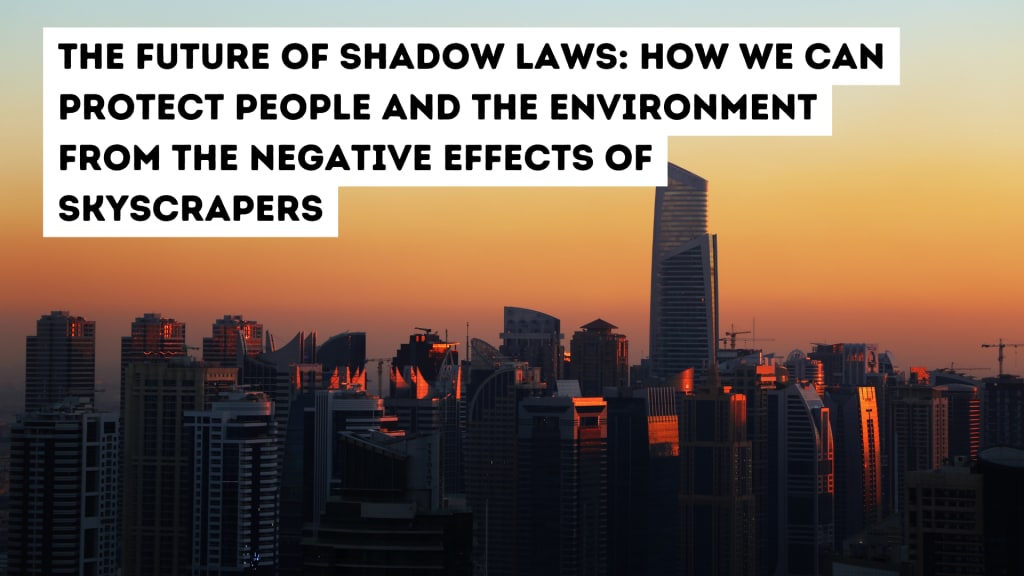The Future of Shadow Laws: How We Can Protect People and the Environment from the Negative Effects of Skyscrapers
A look at the debate over shadow laws, and what we can do to ensure that skyscrapers are built in a way that minimizes their negative impact.

The rise of skyscrapers has been a boon for cities, providing much-needed housing and office space. However, these towering structures have also come with a price: shadows.
The shadow cast by a skyscraper can be significant, blocking out sunlight for hours at a time. This can have a negative impact on both people and the environment.
For people, a lack of sunlight can lead to vitamin D deficiency, depression, and other health problems. It can also make it difficult to grow plants and other vegetation, which can contribute to air pollution and heat island effects.
For the environment, shadows can reduce the amount of solar energy that reaches the ground. This can have a negative impact on the climate, as solar energy is a major source of renewable energy.
In recent years, there has been a growing debate about the impact of skyscrapers on shadows. Some people argue that the benefits of skyscrapers outweigh the costs, while others believe that we need to find ways to reduce the shadow impact of these structures.
There are a number of ways to reduce the shadow impact of skyscrapers. One is to design buildings with angled roofs, which can help to deflect sunlight and reduce the amount of shadow cast. Another is to plant trees and other vegetation around buildings, which can help to block out shadows and provide shade.
Ultimately, the best way to address the shadow impact of skyscrapers is through a combination of planning and design. By working together, we can find ways to build cities that are both livable and sustainable.
The History of Shadow Laws
The debate over the impact of skyscrapers on shadows is not new. In fact, it dates back to the 17th century, when the first shadow laws were enacted in England. These laws were designed to protect property owners from the loss of sunlight due to the construction of new buildings.
The first shadow law in the United States was enacted in New York City in 1959. This law was passed in response to the construction of the Equitable Building, a 38-story skyscraper that cast a shadow over a seven-acre neighborhood.
Since then, many other cities have enacted shadow laws. These laws vary in their scope and enforcement, but they all have the same goal: to protect the public from the negative impacts of shadows cast by skyscrapers.
The Impact of Shadows on People
A lack of sunlight can have a number of negative impacts on people's health. For example, vitamin D deficiency can lead to bone problems, depression, and other health issues.
Sunlight also plays an important role in regulating our circadian rhythms, which are our natural sleep-wake cycles. When we don't get enough sunlight, our circadian rhythms can be disrupted, which can lead to fatigue, insomnia, and other problems.
In addition to the health impacts, a lack of sunlight can also have a negative impact on our mental health. Sunlight exposure has been shown to improve mood, reduce stress, and boost our overall sense of well-being.
The Impact of Shadows on the Environment
Shadows can also have a negative impact on the environment. For example, shadows can reduce the amount of solar energy that reaches the ground. This can have a negative impact on the climate, as solar energy is a major source of renewable energy.
Shadows can also contribute to air pollution and heat island effects. Air pollution is caused by the release of harmful gases and particles into the atmosphere. Heat island effects occur when urban areas become warmer than surrounding areas due to the presence of buildings, roads, and other infrastructure.
The Future of Shadow Laws
The debate over the impact of skyscrapers on shadows is likely to continue for many years to come. As cities continue to grow, the need for housing and office space will increase. This will put pressure on cities to build taller buildings, which will cast larger shadows.
As the debate over shadows continues, it is important to remember that there are both benefits and costs to consider. Skyscrapers can provide much-needed housing and office space, but they can also cast large shadows. By working together, we can find ways to build cities that are both livable and sustainable.
About the Creator
Plantera Digital Media
welcome to my page here i share
- Stories
- Interesting facts about the world around us
- Thought-provoking theories about the nature of reality
- Useful information that can help people in their lives
Enjoyed the story? Support the Creator.
Subscribe for free to receive all their stories in your feed. You could also pledge your support or give them a one-off tip, letting them know you appreciate their work.






Comments
There are no comments for this story
Be the first to respond and start the conversation.